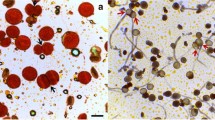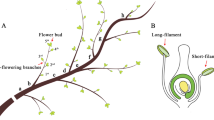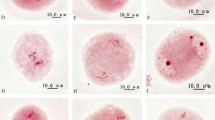Abstract
In order to elucidate the cytological mechanism of 2n pollen formation in Chinese jujube, a cultivar named ‘Linglingzao’ (2n = 2x = 24) which produces relative more 2n pollens naturally was employed for microsporogenesis analysis. Chromosomes paired in 12 bivalents at diakinesis and the first meiotic division was normal, whereas, the second division was characterized by frequent abnormal spindle orientation (parallel and tripolar spindles). Perpendicular, tripolar, and parallel spindles at metaphase II accounted for 72.93, 17.22, and 9.85% respectively. Perpendicular and tripolar spindles led to tetrads and triads formation respectively. Two types of parallel spindles were observed and a significant association correlation (r = 0.84, P < 0.05) between parallel spindle II (fused spindles) and dyads was found which meant only fused spindles can form dyads, while parallel spindle I with a long distance between two sets of chromosomes seemed to lead tetrad formation. At tetrad stage, the observed frequencies of tetrads, triads and dyads were 80.99, 16.40, and 2.61% respectively. By the rule that each tetrad can form four n pollens, each triad can form one 2n pollen and two n pollens, each dyad can form two 2n pollens, the frequency of 2n pollen estimated was 5.71%. Based on the pollen diameter difference between n and 2n pollens, frequency of 2n pollen observed was 6.15%. No significant difference was observed between frequency of 2n pollen estimated and that of observed. The results indicated that, tripolar spindles and fused spindles at metaphase II followed by more triads and few dyads formation at tetrad stage were responsible for the production of 2n pollen in Chinese jujube. 2n gametes observed correspond to first division restitution. Research on the cytological mechanism of unreduced pollen will provide a platform for unreduced pollen induction and polyploidy breeding in Chinese jujube.

Similar content being viewed by others
References
Akutsu M, Kitamura S, Toda R, Miyajima I, Okazaki K (2007) Production of 2n pollen of Asiatic hybrid lilies by nitrous oxide treatment. Euphytica 155:143–152. doi:10.1007/s10681-006-9317-y
Barba-Gonzalez R, Lokker AC, Lim KB, Ramanna MS, Van Tuyl JM (2004) Use of 2n gametes for the production of sexual polyploids from sterile Oriental × Asiatic hybrids of lilies (Lilium). Theor Appl Genet 109:1125–1132. doi:10.1007/s00122-004-1739-0
Barba-Gonzalez R, Lim KB, Ramanna MS, Visser RGF, Van Tuyl JM (2005) Occurrence of 2n gametes in the F1 hybrids of Oriental × Asiatic lilies (Lilium): relevance to intergenomic recombination and backcrossing. Euphytica 143:67–73. doi:10.1007/s10681-005-2657-1
Bretagnolle F, Thompson JD (1995) Gametes with the somatic chromosome number: mechanisms of their formation and role in the evolution of autopolyploid plants. New Phytol 129:1–22. doi:10.1111/j.1469-8137.1995.tb03005.x
Calderini O, Mariani A (1997) Increasing 2n gamete production of diploid alfafa by cycles of phenotypic recurrent selection. Euphytica 93:113–118. doi:10.1023/A:1002978405500
Camadro EL, Peloquin SJ (1980) The occurrence and frequency of 2n pollen in three diploid solanums from northwest Argentina. Theor Appl Genet 56:11–15. doi:10.1007/BF00264421
Camadro EL, Saffarano SK, Espinillo JC, Castro M, Simon PW (2008) Cytological mechanisms of 2n pollen formation in the wild potato Solanum okadae and pollen–pistil relations with the cultivated potato, Solanum tuberosum. Genet Resour Crop Evol 55:471–477. doi:10.1007/s10722-007-9254-1
Carputo D, Barone A (2005) Ploidy level manipulations in potato through sexual hybridisation. Ann Appl Biol 146:71–79. doi:10.1111/j.1744-7348.2005.04070.x
Carputo D, Frusciante L, Peloquin SJ (2003) The role of 2n gametes and endosperm balance number in the origin and evolution of polyploids in the tuber-bearing solanums. Genetics 163:287–294
Crespel L, Gudin S, Meynet J, Zhang D (2002) AFLP-based estimation of 2n gametophytic heterozygosity in two parthenogenetically derived dihaploids of Rosa hybrida L. Theor Appl Genet 104:451–456. doi:10.1007/s001220100695
Crespel L, Ricci SC, Gudin S (2006) The production of 2n pollen in rose. Euphytica 151:155–164. doi:10.1007/s10681-006-9136-1
d’Erfurth I, Jolivet S, Froger N, Catrice O, Novatchkova M, Simon M et al (2008) Mutations in AtPS1 (Arabidopsis thaliana Parallel Spindle 1) lead to the production of diploid pollen grains. PLoS Genet 4(11):1000274. doi:10.1371/journal.pgen.1000274
Dewitte A, Eeckhaut T, Van Huylenbroeck J, Van Bockstaele E (2009) Occurrence of viable unreduced pollen in a Begonia collection. Euphytica 168:81–94. doi:10.1007/s10681-009-9891-x
Dewitte A, Eeckhaut T, Van Huylenbroeck J, Van Bockstaele E (2010a) Induction of 2n pollen formation in Begonia by trifluralin and N2O treatments. Euphytica 171:283–293. doi:10.1007/s10681-009-0060-z
Dewitte A, Eeckhaut T, Van Huylenbroeck J, Van Bockstaele E (2010b) Meiotic aberrations during 2n pollen formation in Begonia. Heredity 104:215–223. doi:10.1038/hdy.2009.111
El Mokadem H, Crespel L, Meynet J, Gudin S (2002) The occurrence of 2n-pollen and the origin of sexual polyploids in dihaploid roses (Rosa hybrida L.). Euphytica 125:169–177. doi:10.1023/A:1015830803459
Gallo PH, Micheletti PL, Boldrini KR, Risso-Pascotto C, Pagliarini MS, do Valle CB (2007) 2n Gamete formation in the genus Brachiaria (Poaceae:Paniceae). Euphytica 154:255–260. doi:10.1007/s10681-006-9294-1
Geraci G, Esen A, Soost RK (1975) Triploid progenies from 2x × 2x cross of Citrus cultivars. J Hered 66:177–178
Hancock JF (1997) The colchicine story. HortScience 32:1011–1012
Harlan JR, De Wet JMJ (1975) On Ö Winge and a prayer: the origins of polyploidy. Bot Rev 41:361–390. doi:10.1007/BF02860830
Hayashi M, Kato J, Ohashi H, Mii M (2009) Unreduced 3x gamete formation of allotriploid hybrid derived from the cross of Primula denticulata (4x) × P. rosea (2x) as a causal factor for producing pentaploid hybrids in the backcross with pollen of tetraploid P. denticulata. Euphytica 169:123–131. doi:10.1007/s10681-009-9955-y
Jauhar PP (2003) Formation of 2n gametes in durum wheat haploids: sexual polyploidization. Euphytica 133:81–94. doi:10.1023/A:1025692422665
Johnston SA, den Nijs TPM, Hanneman RE Jr, Peloquin SJ (1980) The significance of genic balance to endosperm development in interspecific crosses. Theor Appl Genet 57:5–9. doi:10.1007/BF00276002
Katsiotis A, Forsberg RA (1995) Discovery of 2n gametes in tetraploid oat Avena vaviloviana. Euphytica 81:1–6. doi:10.1007/BF00022452
Lyrene PM, Vorsa N, Ballington JR (2003) Polyploidy and sexual polyploidization in the genus Vaccinium. Euphytica 133:27–36. doi:10.1023/A:1025608408727
Pagliarini MS, Takayama SY, de Freitas PM, Carraro LR, Admowski EV, Silva N, Batista LAR (1999) Failure of cytokinesis and 2n gamete formation in Brazilian accessions of Paspalum. Euphytica 108:129–135. doi:10.1023/A:1003660327223
Peloquin SJ, Boiteux LS, Simon PW, Jansky SH (2008) A chromosome-specific estimate of transmission of heterozygosity by 2n gametes in potato. J Hered 99:177–181. doi:10.1093/jhered/esm110
Peng B (2008) Study on 2n pollen in Chinese jujube. Dissertation, Agricultural University of Hebei
Ramanna MS (1979) A re-examination of the mechanisms of 2n gamete formation in potato and its implications for breeding. Euphytica 28:537–561. doi:10.1007/BF00038921
Ramanna MS (1983) First division restitution gametes through fertile desynaptic mutants of potato. Euphytica 32:337–350. doi:10.1007/BF00021442
Ramanna MS, Kuipers AGJ, Jacobsen E (2003) Occurrence of numerically unreduced (2n) gametes in Alstroemeria interspecific hybrids and their significance for sexual polyploidisation. Euphytica 133:95–106. doi:10.1023/A:1025652808553
Sugiura A, Ohkuma T, Choi YA, Tao R, Tamura M (2000) Production of nonaploid (2n = 9x) Japanese persimmons (Diospyros kaki) by pollination with unreduced (2n = 6x) pollen and embryo rescue culture. J Am Soc Hortic Sci 125(5):609–614
Taschetto OM, Pagliarini MS (2003) Occurrence of 2n and jumbo pollen in the Brazilian ginseng (Pfaffia glomerata and P. tuberosa). Euphytica 133:139–145. doi:10.1023/A:1025683511162
Tavoletti S, Mariani A, Veronesi F (1991) Cytological analysis of macro- and micro-sporogenesis of a diploid alfalfa clone producing male and female 2n gamete. Crop Sci 31:1258–1263
Tavoletti S, Pesaresi P, Barcaccia G, Albertini E, Veronesi F (2000) Map** the jp (jumbo pollen) gene and QTLs involved in multinucleate microspore formation in diploid alfalfa. Theor Appl Genet 101:372–378. doi:10.1007/s001220051493
Ton PM, Nijs D, Peloquin SJ (1977) Polyploid evolution via 2n gametes. Am Potato J 54:377–386. doi:10.1007/BF02852758
Van Laere K, Leus L, Van Huylenbroeck J, Van Bockstaele E (2009) Interspecific hybridisation and genome size analysis in Buddleja. Euphytica 166:445–456. doi:10.1007/s10681-008-9844-9
Van Tuyl JM, Lim KB (2003) Interspecific hybridisation and polyploidisation as tools in ornamental plant breeding. Acta Hortic 612:13–22
Veilleux R (1985) Diploid and polyploid gametes in crop plants: mechanisms of formation and utilization in plant breeding. Plant Breed Rev 3:253–288
Veilleux RE, McHale NA, Lauer FI (1982) 2n gametes in diploid Solanum: frequency and types of spindle abnormalities. Genome 24:301–314. doi:10.1139/g82-032
Wan Y, Duncan DR, Rayburn AL, Petolino JF, Widholm JM (1991) The use of antimicrotubule herbicides for the production of doubled haploid plants from anther-derived maize callus. Theor Appl Genet 81:205–211. doi:10.1007/BF00215724
Xu LQ, Zhang QL, Luo ZR (2008) Occurrence and cytological mechanism of 2n pollen formation in Chinese Diospyros spp. (Ebenaceae) staminate germplasm. J Hortic Sci Biotech 83(5):668–672
Yanagi T, Hummer KE, Iwata T, Sone K, Nathewet P, Takamura T (2010) Aneuploid strawberry (2n = 8x + 2 = 58) was developed from homozygous unreduced gamete (8x) produced by second division restitution in pollen. Sci Hortic 125:123–128
Zhang ZH, Kang XY (2010) Cytological characteristics of numerically unreduced pollen production in Populus tomentosa Carr. Euphytica 173:151–159. doi:10.1007/s10681-009-0051-0
Zhang JF, Wei ZZ, Li D, Li BL (2009) Using SSR markers to study the mechanism of 2n pollen formation in Populus × euramericana (Dode) Guinier and P. × popularis. Ann For Sci 66:506. doi:10.1051/forest/2009032
Zhou SJ, Ramanna MS, Visser RGF, van Tuyl JM (2008) Analysis of the meiosis in the F1 hybrids of Longiflorum × Asiatic (LA) of lilies (Lilium) using genomic in situ hybridization. J Genet Genomics 35:687–695. doi:10.1016/S1673-8527(08)60091-0
Acknowledgments
The authors want to thank the National Key Technology R&D Program (2007BAD36B07, 2008BAD92B03), the Provincial Natural Science Fund of Hebei (C2007000452) and Agricultural Scientific Research Achievement Transformation Program (2010GB2A200027) for financial assistance.
Author information
Authors and Affiliations
Corresponding author
Rights and permissions
About this article
Cite this article
Xue, Z., Liu, P. & Liu, M. Cytological mechanism of 2n pollen formation in Chinese jujube (Ziziphus jujuba Mill. ‘Linglingzao’). Euphytica 182, 231–238 (2011). https://doi.org/10.1007/s10681-011-0461-7
Received:
Accepted:
Published:
Issue Date:
DOI: https://doi.org/10.1007/s10681-011-0461-7




